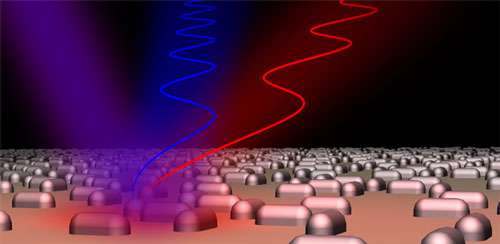| Posted: Aug 28, 2014 |
Nanotechnology used to create next-generation holograms for information storage
|
|
(Nanowerk News) Researchers from the University of Cambridge have developed a new method for making multi-coloured holograms from a thin film of silver nanoparticles, which could greatly increase the storage capabilities of typical optical storage devices.
|
|
The interference produced by the interaction of light with the nanoparticles allows the holograms to go beyond the normal limits of diffraction, or the way in which waves spread or bend when they encounter an opening or obstacle. The results were recently published in the journal Proceedings of the National Academy of Sciences ("Plasmonic nanoparticle scattering for color holograms").
|
 |
| Multi-coloured holograms (Image: Yunuen Montelongo)
|
|
When metallic particles have dimensions on the nanoscale, they display iridescent colours. A noted example of this phenomenon is the Lycurgus cup, which was made in the 4th century during the Roman Empire, and changes colour when held up to the light. An optical phenomenon, known as dichroism, occurs when the colour of the cup changes from green to red according to the position of the light source.
|
|
Roman artisans made the cup by incorporating nanoparticles into glass, although they would have been unaware of the specific physical characteristics responsible for the colours observed in the cup. Only in the last 20 years have scientists begun to understand this phenomenon, but they have not been able to utilise its effects in currently-available technology.
|
|
To apply this phenomenon in modern optics, an interdisciplinary team of researchers have created nanoscale metallic nanoparticle arrays that mimic the colour effects of the Lycurgus cup, to form multi-colour holograms. This breakthrough could lead to the shrinkage of standard bulky optical devices.
|
|
“This technology will lead to a new range of applications in the area of photonics, as conventional optical components simply cannot achieve this kind of functionality,” said Yunuen Montelongo, a PhD student from the Department of Engineering, who led the research. “The potential of this technology will be realised when they are mass produced and integrated into the next generation of ultra-thin consumer electronics.”
|
|
Using a single thin layer of silver, Montelongo and his colleagues patterned colourful holograms containing 16 million nanoparticles per square millimetre. Each nanoparticle, approximately 1000 times smaller than the width of a human hair, scatters light into different colours depending on its particular size and shape. The scattered light from each of the nanoparticles interacts and combines with all of the others to produce an image.
|
|
The device can display different images when illuminated with a different colour light, a property not seen before in a device of this type. Furthermore, when multiple light sources are shone simultaneously, a multi-colour image is projected.
|
|
These holographic devices are between 10 and 100 times smaller than just one of the millions of pixels used to produce a colour image on a typical laptop screen, yet they project a complete multi-colour image to the eye. This is possible through plasmonics: the study of how light interacts with metals on the nanoscale, which allows the researchers to go beyond the capability of conventional optical technologies.
|
|
“This hologram may find a wide range of applications in the area of displays, optical data storage, and sensors,” said PhD student Calum Williams, a co-author of the paper. “However, scalable approaches are needed to fulfil the potential of this technology.”
|
|
Currently, the team is exploring various optical mechanisms involved in the light-matter interaction at nanoscale. The future research will involve the construction of three-dimensional dynamic displays for consumer electronics and the researchers are already looking into tuning these devices for reconfigurable display technologies.
|

